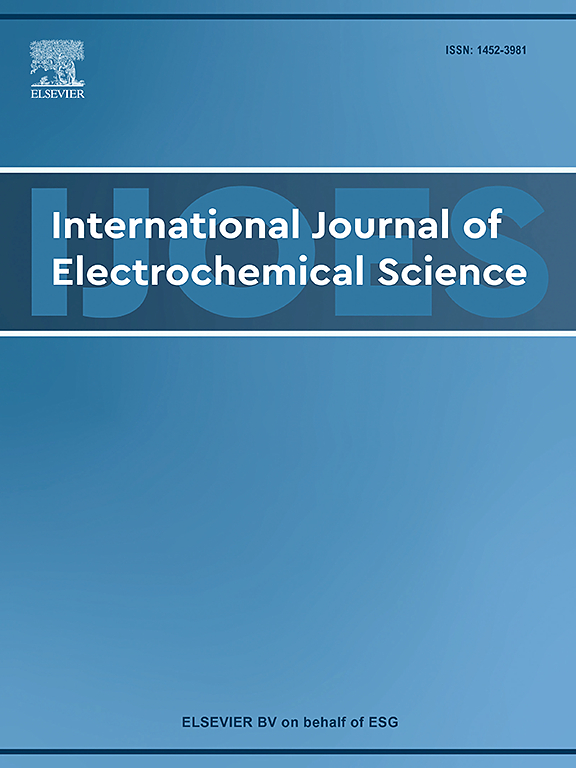A study on the corrosion inhibition impact of newly synthesized quinazoline derivatives on mild steel in 1.0 M HCl: Experimental, surface morphological (SEM-EDS and FTIR) and computational analysis
IF 1.3
4区 化学
Q4 ELECTROCHEMISTRY
International Journal of Electrochemical Science
Pub Date : 2024-09-17
DOI:10.1016/j.ijoes.2024.100795
引用次数: 0
Abstract
Two new quinazoline derivatives were investigated in this research, namely 12-(4-methoxyphenyl) and 3,3-dimethyl-12-(4-nitrophenyl)-3,4,5,12-tetrahydrobenzo[4,5]imidazo[2, 1-b]quinazolin-1(2 H)-one (Q-NO2). In 1 M hydrochloric acid (HCl), −3,3-dimethyl-3,4,5,12-tetrahydrobenzo[4,5]imidazo[2,1-b]quinazolin-1(2 H)-one (Q-OMe) proved to be an extremely effective corrosion inhibitor for mild steel. The maximum inhibition efficiencies of 94.7 % for Q-NO2 and 96.7 % for Q-OMe were achieved when the performance of the inhibitors was evaluated using potentiodynamic polarization (PDP), electrochemical frequency modulation (EFM) and electrochemical impedance spectroscopy (EIS). According to these findings, the Q-NO2 and Q-OMe molecules have a remarkable ability to generate a dense, resistant protective film on the mild steel surface. This protective film acted as a barrier, effectively blocking the penetration of corrosive ions and their interaction with the mild steel substrate. The adsorption characteristics of these inhibitors on the mild steel surface conform to the Langmuir adsorption isotherm. PDP experiments show that Q-NO2 and Q-OMe act as mixed-type inhibitors for mild steel in 1.0 M HCl. Surface characterization by energy dispersive X-ray spectroscopy (EDS), Fourier transform infrared spectroscopy (FT-IR) and scanning electron microscopy (SEM) determined that a protective layer had formed on the steel surface, preventing corrosion. The experimental results were corroborated by theoretical insights from density functional theory (DFT), which further clarified the molecular adsorption processes. This work highlights the potential of Q-NO2 and Q-OMe as effective inhibitors to protect mild steel in acidic situation.
研究新合成的喹唑啉衍生物在 1.0 M HCl 溶液中对低碳钢的缓蚀作用:实验、表面形态(SEM-EDS 和 FTIR)和计算分析
本研究调查了两种新的喹唑啉衍生物,即 12-(4-甲氧基苯基)和 3,3-二甲基-12-(4-硝基苯基)-3,4,5,12-四氢苯并[4,5]咪唑并[2,1-b]喹唑啉-1(2 H)-酮 (Q-NO2)。在 1 M 盐酸(HCl)中,-3,3-二甲基-3,4,5,12-四氢苯并[4,5]咪唑并[2,1-b]喹唑啉-1(2 H)-酮(Q-OMe)被证明是一种极其有效的低碳钢缓蚀剂。在使用电位极化(PDP)、电化学频率调制(EFM)和电化学阻抗光谱(EIS)对抑制剂的性能进行评估时,Q-NO2 和 Q-OMe 的最大抑制效率分别达到 94.7% 和 96.7%。根据这些研究结果,Q-NO2 和 Q-OMe 分子具有在低碳钢表面生成一层致密、耐腐蚀保护膜的显著能力。这层保护膜就像一道屏障,有效地阻止了腐蚀性离子的渗透及其与低碳钢基体的相互作用。这些抑制剂在低碳钢表面的吸附特性符合 Langmuir 吸附等温线。PDP 实验表明,Q-NO2 和 Q-OMe 在 1.0 M HCl 溶液中对低碳钢起着混合型抑制作用。通过能量色散 X 射线光谱(EDS)、傅立叶变换红外光谱(FT-IR)和扫描电子显微镜(SEM)进行的表面表征确定,钢表面形成了保护层,从而防止了腐蚀。密度泛函理论(DFT)的理论见解证实了实验结果,进一步阐明了分子吸附过程。这项研究凸显了 Q-NO2 和 Q-OMe 作为有效抑制剂在酸性环境中保护低碳钢的潜力。
本文章由计算机程序翻译,如有差异,请以英文原文为准。
求助全文
约1分钟内获得全文
求助全文
来源期刊
CiteScore
3.00
自引率
20.00%
发文量
714
审稿时长
2.6 months
期刊介绍:
International Journal of Electrochemical Science is a peer-reviewed, open access journal that publishes original research articles, short communications as well as review articles in all areas of electrochemistry: Scope - Theoretical and Computational Electrochemistry - Processes on Electrodes - Electroanalytical Chemistry and Sensor Science - Corrosion - Electrochemical Energy Conversion and Storage - Electrochemical Engineering - Coatings - Electrochemical Synthesis - Bioelectrochemistry - Molecular Electrochemistry

 求助内容:
求助内容: 应助结果提醒方式:
应助结果提醒方式:


